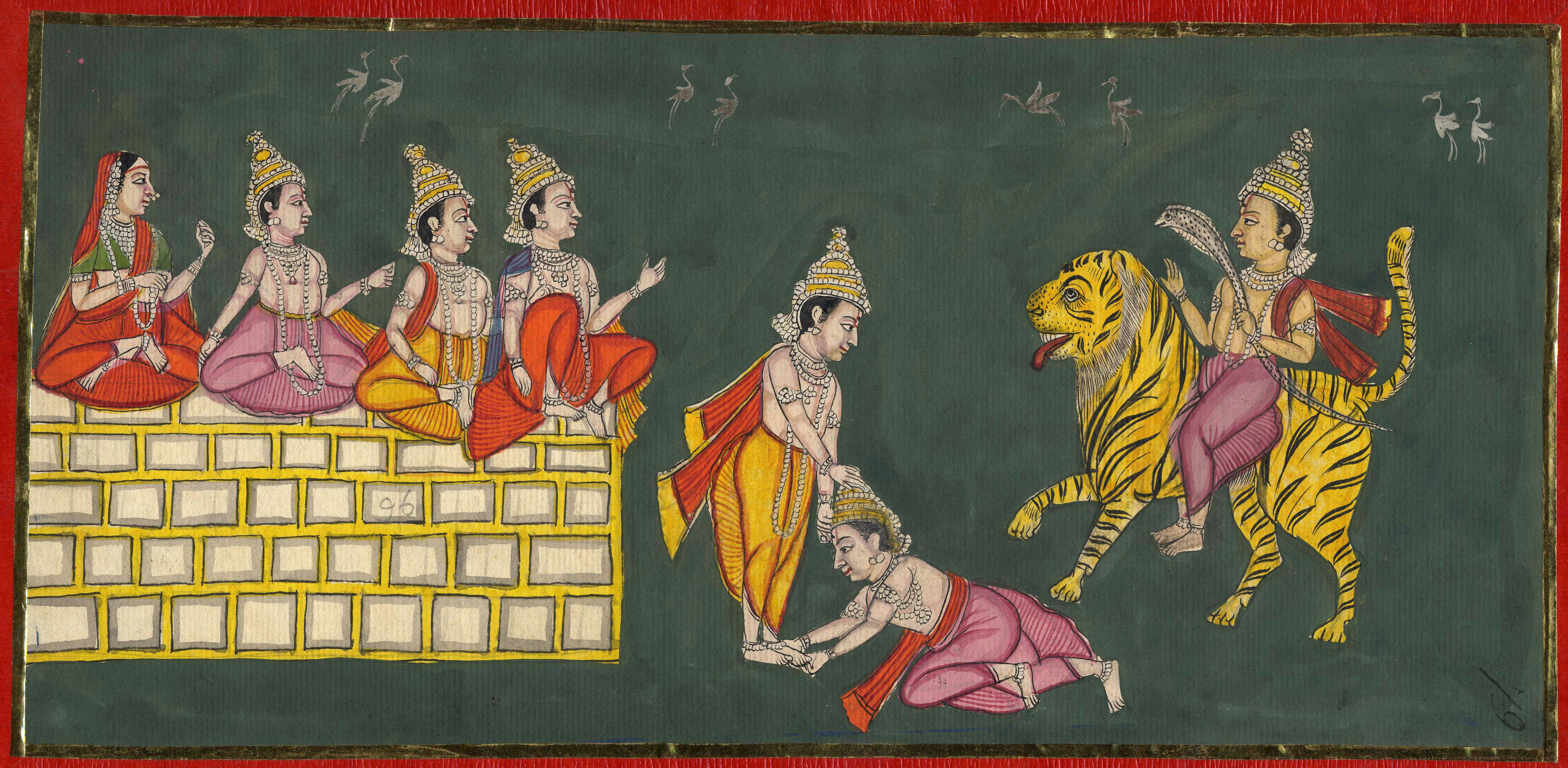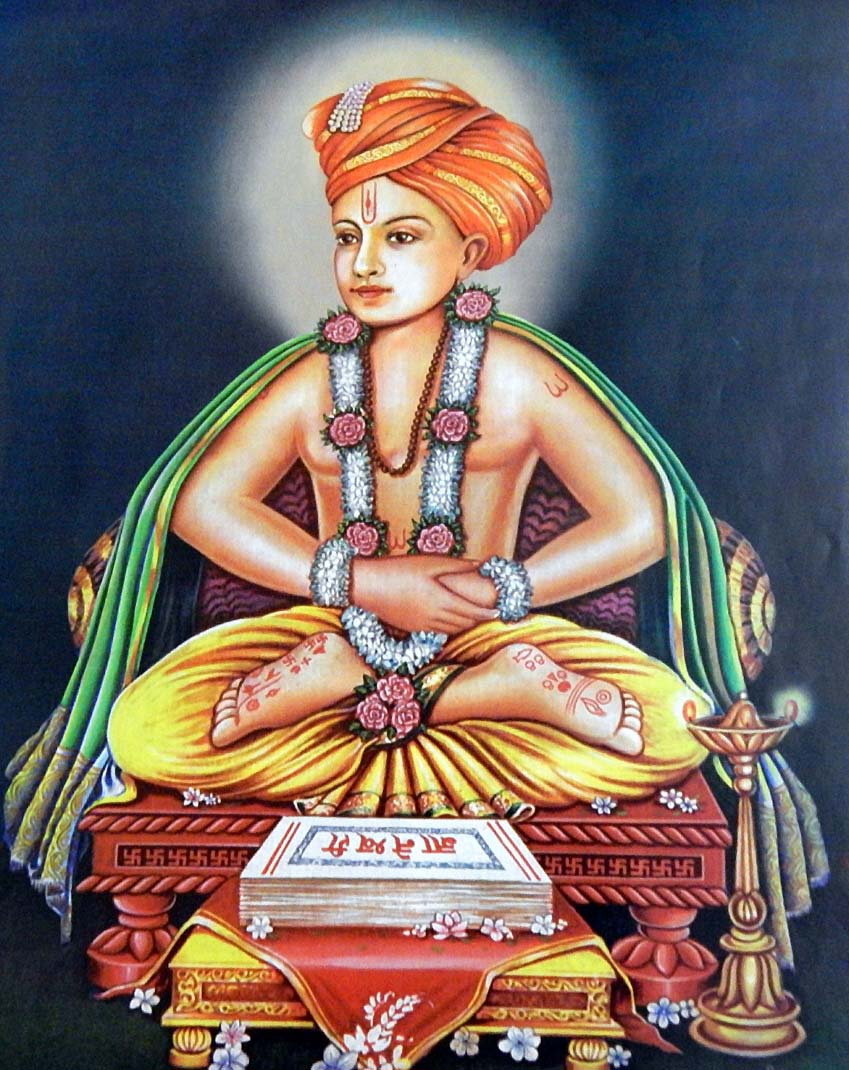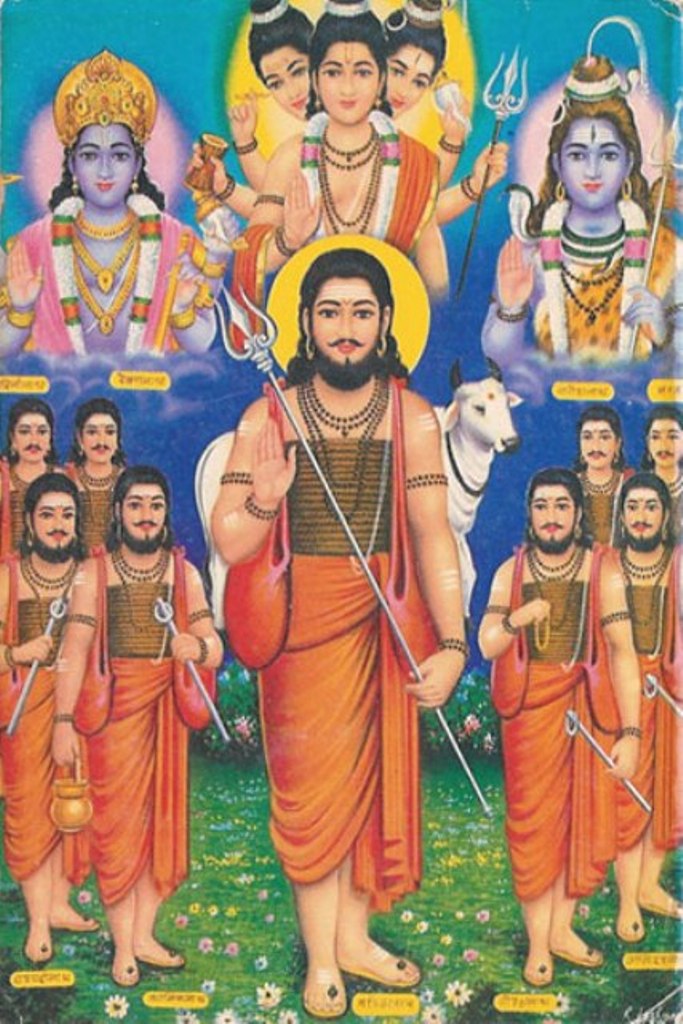|
Jnanesvar
Sant Dnyaneshwar (Marathi pronunciation: ̪ɲaːn̪eʃʋəɾ, (Devanagari : सन्त ज्ञानेश्वर), also referred to as Jñāneśvara, Jñānadeva, Dnyandev or Mauli or Dnyaneshwar Vitthal Kulkarni (1275–1296 (living samadhi)), was a 13th-century Indian Marathi saint, poet, philosopher and yogi of the Nath and Varkari tradition. In his short life of 21 years, he authored ''Dnyaneshwari'' (a commentary on the ''Bhagavad Gita'') and ''Amrutanubhav''. These are the oldest surviving literary works in the Marathi language, and considered to be milestones in Marathi literature. Sant Dnyaneshwar's ideas reflect the non-dualistic Advaita Vedanta philosophy and an emphasis on Yoga and bhakti towards Vithoba, an incarnation of Vishnu. His legacy inspired saint-poets such as Eknath and Tukaram, and he is one of the founders of the Varkari (Vithoba-Krishna) Bhakti movement tradition of Hinduism in Maharashtra. Dnyaneshwar undertook samadhi at Alandi in 1296 by e ... [...More Info...] [...Related Items...] OR: [Wikipedia] [Google] [Baidu] |
Dnyaneshwari
The ''Dnyaneshwari'' () (IAST: Jñānēśvarī), also referred to as ''Jnanesvari'', ''Jnaneshwari'' or ''Bhavartha Deepika'', is a commentary on the ''Bhagavad Gita'' written by the Marathi saint and poet Sant Dnyaneshwar in 1290 CE. Dnyaneshwar (born 1275) lived a short life of 22 years, and this commentary is notable to have been composed in his teens. The text is the oldest surviving literary work in the Marathi language, one that inspired major Bhakti movement saint-poets such as Eknath and Tukaram of the Varkari (Vithoba) tradition. The ''Dnyaneshwari'' interprets the ''Bhagavad Gita'' in the Advaita Vedanta tradition of Hinduism. The philosophical depth of the text has been praised for its aesthetic as well as scholarly value. According to Pradhan and Lambert, the reliable dating of ''Dnyaneshwari'' to 1290 CE is based on textual and corroborative reference to the Yadava king Ramadeva as well as the name of the scribe and the ''samvat'' of its completion. It is also c ... [...More Info...] [...Related Items...] OR: [Wikipedia] [Google] [Baidu] |
Bhagavad Gita
The Bhagavad Gita (; ), often referred to as the Gita (), is a Hindu texts, Hindu scripture, dated to the second or first century BCE, which forms part of the Hindu epic, epic poem Mahabharata. The Gita is a synthesis of various strands of Indian religious thought, including the Vedic concept of ''dharma'' (duty, rightful action); samkhya-based ''yoga'' and ''jnana'' (knowledge); and ''bhakti'' (devotion). Among the Hindu denominations, Hindu traditions, the text holds a unique pan-Hindu influence as the most prominent sacred text and is a central text in Vedanta and the Vaishnava, Vaishnava Hindu tradition. While traditionally attributed to the sage Veda Vyasa, the Gita is historiographically regarded as a composite work by multiple authors. Incorporating teachings from the Upanishads and the samkhya Yoga (philosophy), yoga philosophy, the Gita is set in a narrative framework of dialogue between the pandava prince Arjuna and his charioteer guide Krishna, an avatar of Vishnu, a ... [...More Info...] [...Related Items...] OR: [Wikipedia] [Google] [Baidu] |
Alandi
Alandi (Marathi pronunciation: ːɭən̪d̪iː is a town and a municipal council in the Pune district in the state of Maharashtra, India. The town is popular as a place of pilgrimage and for being the resting place of the 13th century Marathi saint Sant Dnyaneshwar. History Alandi has a long history but gained prominence in the 13th century when Dnyaneshwar (1275–1296) decided to entomb, otherwise known as '' sanjeevan samadhi'', himself in a samadhi, a form of shrine, under the then existing Siddheshwar temple complex in 1296. A temple was built over the Samadhi by Ambekar Deshpande in around 1580–1600. Further additions to the temple were made during the Maratha Empire era by Maratha nobles and the Peshwa. In 1778, Alandi was granted to Mahadji Shinde, the powerful Maratha statesman of the Maratha confederacy at that time, by the Peshwa. For two decades after that, the Shinde family were the main sponsors of various renovations of the temple. In the 1820s, Haiba ... [...More Info...] [...Related Items...] OR: [Wikipedia] [Google] [Baidu] |
Nath
Natha, also called Nath (), are a Shaivism, Shaiva sub-tradition within Hinduism in India and Nepal. A medieval movement, it combined ideas from Buddhism, Shaivism, Tantra and Yoga traditions of the Indian subcontinent.Natha: Indian religious sect Encyclopedia Britannica (2007) The Naths have been a confederation of devotees who consider Shiva as their first lord or guru, with varying lists of additional gurus. Of these, the 9th or 10th century Matsyendranatha and the ideas and organization mainly developed by Gorakhnath are particularly important. Gorakhnath is considered the originator of the Nath Panth. The Nath tradition has an extensive Shaivism-related theological literature of its own, most of which is ... [...More Info...] [...Related Items...] OR: [Wikipedia] [Google] [Baidu] |
Devanagari
Devanagari ( ; in script: , , ) is an Indic script used in the Indian subcontinent. It is a left-to-right abugida (a type of segmental Writing systems#Segmental systems: alphabets, writing system), based on the ancient ''Brāhmī script, Brāhmī'' script. It is one of the official scripts of India, official scripts of India and Nepal. It was developed in, and was in regular use by, the 8th century CE. It had achieved its modern form by 1000 CE. The Devanāgarī script, composed of 48 primary characters, including 14 vowels and 34 consonants, is the fourth most widely List of writing systems by adoption, adopted writing system in the world, being used for over 120 languages, the most popular of which is Hindi (). The orthography of this script reflects the pronunciation of the language. Unlike the Latin alphabet, the script has no concept of letter case, meaning the script is a unicase, unicameral alphabet. It is written from left to right, has a strong preference for symmetri ... [...More Info...] [...Related Items...] OR: [Wikipedia] [Google] [Baidu] |
Guru
Guru ( ; International Alphabet of Sanskrit Transliteration, IAST: ''guru'') is a Sanskrit term for a "mentor, guide, expert, or master" of certain knowledge or field. In pan-Indian religions, Indian traditions, a guru is more than a teacher: traditionally, the guru is a reverential figure to the disciple (or ''wikt:शिष्य, shisya'' in Sanskrit, literally ''seeker [of knowledge or truth'']) or student, with the guru serving as a "counsellor, who helps mould values, shares experiential knowledge as much as Knowledge#Hinduism, literal knowledge, an Role model, exemplar in life, an inspirational source and who helps in the spiritual evolution of a student". Whatever language it is written in, Judith Simmer-Brown says that a tantra, tantric spiritual text is often codified in an obscure twilight language so that it cannot be understood by anyone without the verbal explanation of a qualified teacher, the guru. A guru is also one's spiritual guide, who helps one to discover the ... [...More Info...] [...Related Items...] OR: [Wikipedia] [Google] [Baidu] |
Eknath
Eknath (IAST: Eka-nātha, Marathi pronunciation: knath (1533–1599), was an Indian Hindu Vaishnava saint, philosopher and poet. He was a devotee of the Hindu deity Vitthal and is a major figure of the Warkari movement. Eknath is often viewed as a spiritual successor to the prominent Marathi saints Dnyaneshwar and Namdev. Biography Precise details of his life remain obscure. It is generally believed that Eknath lived during the latter three-quarters of the 16th-century. He was born into a Deshastha Rigvedi Brahmin family of Vishwamitra gotra to Suryanarayan and Rukmini Bai at Paithan, present-day Maharashtra and was a follower of the Ashvalayana Sutra. His father probably held the title of Kulkarni and kept financial accounts. Their family deity is Ekvira Devi (or Renuka). His parents died while Eknath was young. He was then raised by his grandfather, Chakrapani. His great-grandfather Bhanudas was another revered saint of the Warkari sect. Eknath was a disciple of J ... [...More Info...] [...Related Items...] OR: [Wikipedia] [Google] [Baidu] |
Vishnu
Vishnu (; , , ), also known as Narayana and Hari, is one of the Hindu deities, principal deities of Hinduism. He is the supreme being within Vaishnavism, one of the major traditions within contemporary Hinduism, and the god of preservation (sattva). Vishnu is known as ''The Preserver'' within the Trimurti, the triple deity of Para Brahman, supreme divinity that includes Brahma and Shiva.Gavin Flood, An Introduction to Hinduism' () (1996), p. 17. In Vaishnavism, Vishnu is the supreme Lord who creates, protects, and transforms the Hindu cosmology, universe. Tridevi is stated to be the energy and creative power (Shakti) of each, with Lakshmi being the equal complementary partner of Vishnu. He is one of the five equivalent deities in Panchayatana puja of the Smarta tradition of Hinduism. According to Vaishnavism, the supreme being is with qualities (Saguna Brahman, Saguna), and has definite form, but is limitless, transcendent and unchanging absolute Brahman, and the primal Atma ... [...More Info...] [...Related Items...] OR: [Wikipedia] [Google] [Baidu] |
Vithoba
Vithoba (IAST: ''Viṭhobā''), also known as Vitthala (IAST: ''Viṭṭhala''), and Panduranga (IAST: ''Pāṇḍuraṅga''), is a Hindu deity predominantly worshipped in the Indian states of Maharashtra and Karnataka. He is a form of the Hindu deity Vishnu in his avatar: Krishna. Vithoba is often depicted as a dark young boy, standing arms akimbo on a brick, sometimes accompanied by his consort Rakhumai. Vithoba is the focus of an essentially monotheistic, non-ritualistic bhakti-driven Varkari faith in Maharashtra and the Haridasa sect established in Dvaita Vedanta in Karnataka. Vithoba Temple, Pandharpur is his main temple. Vithoba legends revolve around his devotee Pundalik who is credited for bringing the deity to Pandharpur, and around Vithoba's role as a saviour to the poet-saints of the Varkari faith. The Varkari poet-saints are known for their unique genre of devotional lyric, the abhang, dedicated to Vithoba and composed in Marathi. Other devotional literature dedi ... [...More Info...] [...Related Items...] OR: [Wikipedia] [Google] [Baidu] |
Marathi Literature
Marathi literature is the body of literature of Marathi, an Indo-Aryan language spoken mainly in the Indian state of Maharashtra and written in the Devanagari and Modi script. History Early history As a written language, Marathi is probably first attested in a 739 CE copper-plate inscription found in Satara. Several inscriptions dated to the second half of the 11th century feature Marathi, which is usually appended to Sanskrit or Kannada in these inscriptions. The earliest Marathi-only inscriptions are the ones issued during the Shilahara rule, including a c. 1012 CE stone inscription from Akshi taluka of Raigad district, and a 1060 or 1086 CE copper-plate inscription from Dive that records a land grant ( agrahara) to a Brahmin. A 2-line 1118 CE Marathi inscription at Shravanabelagola records a grant by the Hoysalas. These inscriptions suggest that Marathi was a standard written language by the 12th century. However, there is no record of any actual literature produced in Mar ... [...More Info...] [...Related Items...] OR: [Wikipedia] [Google] [Baidu] |






